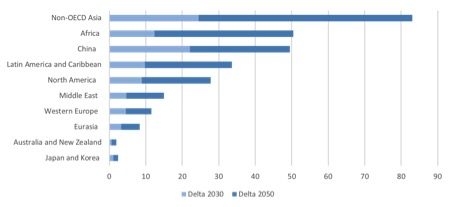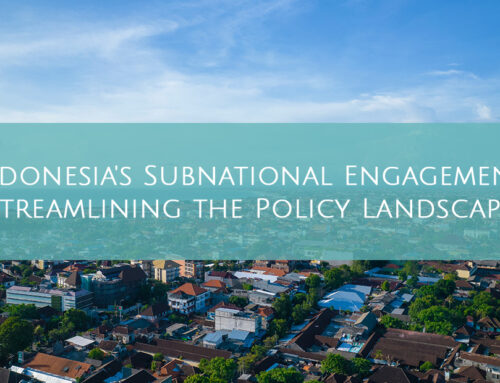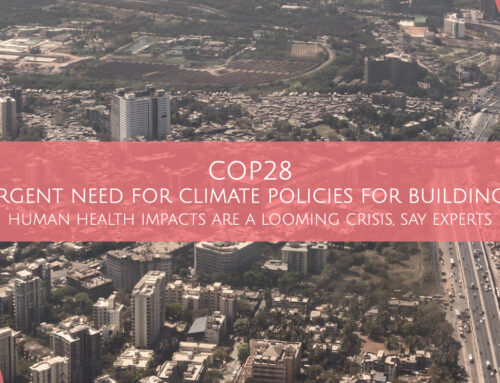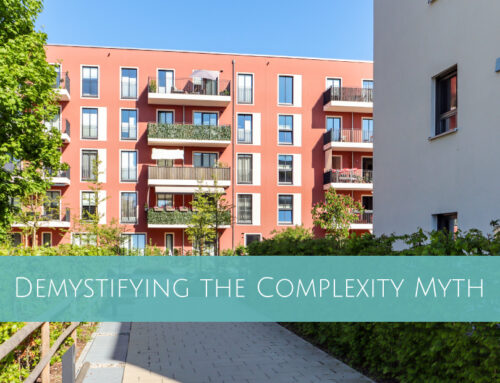A Policy Strategy for Decarbonizing the Buildings Sector
Over the next 4 decades building floor area is projected to grow by 280 billion m2 (over 3 trillion sq.ft). After demolition rates are factored in this equates to adding an average of 6.5 billion m2(70 billion sq.ft) of new floor area annually – equivalent to constructing the entire building stock of Japan every year from now until 2060 (IEA, 2017). The majority of this growth in new floor area will occur in non-OECD Asia (India and S.E. Asia) and China, then Africa (after 2030) (Figure 1). As a result, global building energy consumption and related GHG emissions continue to rise and be locked in for decades. Despite improvements in energy efficiency, the buildings sector overall is not decarbonizing, nor becoming more resource-efficient.

Figure 1:Projected regional growth in building floor area (m2) 2015 – 2050 Source: Global ABC, 2016 p5
The buildings sector must decarbonize by decreasing energy intensity by at least 80% by 2030 and be climate neutral by 2050 if we are to meet the Paris Agreement Goal of keeping global warming to 1.5oC above pre-industrial levels. This will require a doubling of the rate of energy efficiency improvement in the sector to 2% per year, and a six-fold increase from the current rate of construction of net zero energy buildings and renovations by 2030¹. To succeed, all jurisdictions must implement ambitious sustainable buildings policies that attract the necessary investment to drive the transformation to low-carbon construction and real-estate markets. Building energy codes are the foundation of such policy packages because they work to reduce energy demand and associated CO2 emissions, while increasing energy productivity. When effectively implemented as part of a policy package that includes incentive programs, awareness raising and capacity building, they reduce emissions, improve health, stimulate investment, and create jobs.
Between 2010 and 2016, a combination of building energy policies, technology choices and energy-efficiency measures avoided 24 EJ of growth in final energy demand globally from the building sector. This is equivalent to the energy produced by 340 coal-fired power stations over the same period (IEA, 2017)². Despite this as of 2017 only 62 of 197 countries had implemented some kind of building energy code, missing nearly 2GtCO2eof the Building sector’s technical mitigation potential.
Residential building energy use accounts for nearly ¾ of total global annual consumption, and has increased by an average of 30% since 1990. This equates to about 42% of annual building-related GHG emissions or 5.5GtCO2. In rapidly growing economies such India and Indonesia residential building energy use has increased by more than 50% over the same period. This trend is accelerating, with the largest projected growth in energy demand from buildings in the next decade coming from new residential construction in warm climates in Non-OECD Asia.
The Global Building Performance Network’s (GBPN)[1]focus over the next two years is therefore on Asian and S.E. Asian markets where floor area and energy demand for space cooling is increasing rapidly, and building energy demand remains poorly regulated. GBPN are investing in four strategic funds that aim to increase the ambition, adoption and effective implementation of building energy codes and complimentary polices in high mitigation potential markets across South East Asia with a focus on expanding the coverage of residential energy codes in Indonesia and India, training and capacity building in investment grade policies and high-performance buildings, and global knowledge exchange and policy insight services though our on-line hub www.gbpn.org.
The Paris Agreement has catalysed renewed demand for policy expertise and technical assistance to engage the building sector in helping to achieve Nationally Determined Contributions (NDCs) and sub-national climate commitments. There is now finally a clear global framework for action to decarbonize the buildings sector, and plenty of economic incentives to do so. We therefore expect to see increased regulation of building energy performance, and requirements for integrating renewables over the next five years.
Please join the GBPN and to stay up to speed on the policy best-practices that are being deployed to decarbonise the sector.
- Abergel, T., Dean, B., Dulac, J. (2017) Towards zero-emission, efficient and resilient buildings: Global Status Report Global Alliance on Buildings & Construction, Paris November.
- IEA (2017) Energy efficiency market report 2017. Paris: International Energy Agency.
Related News
- [News] Climate success in Paris: the buildings sector’s key role
- [Event] Buildings Day at COP21 – 3 December 2015, Paris
- [News] Content Available from the Webinar of 22 Oct 15 – Implementing Building Energy Codes
- [Event] Meet GBPN at COP21
- Join the Global Alliance for Buildings and Construction!
- GBPN sharpens its focus on decarbonising housing in India and South East Asia
- GBPN joins forces with AEEE and CEPT in efforts to decarbonize India’s residential building sector
- Webinar “Transforming the buildings sector through ambitious NDCs: Status of and examples from Asia-Pacific”
Share This Story, Choose Your Platform!
Stay in touch with how we’re transforming the buildings sector
GBPN runs innovative building policy reform programs in key regions around the world that aim to tackle the climate emergency by decarbonising the buildings sector. Stay up to date with our newsletter.
Stay in touch with how we’re transforming the buildings sector
GBPN runs innovative building policy reform programs in key regions around the world that aim to tackle the climate emergency by decarbonising the buildings sector. Stay up to date with our newsletter.






